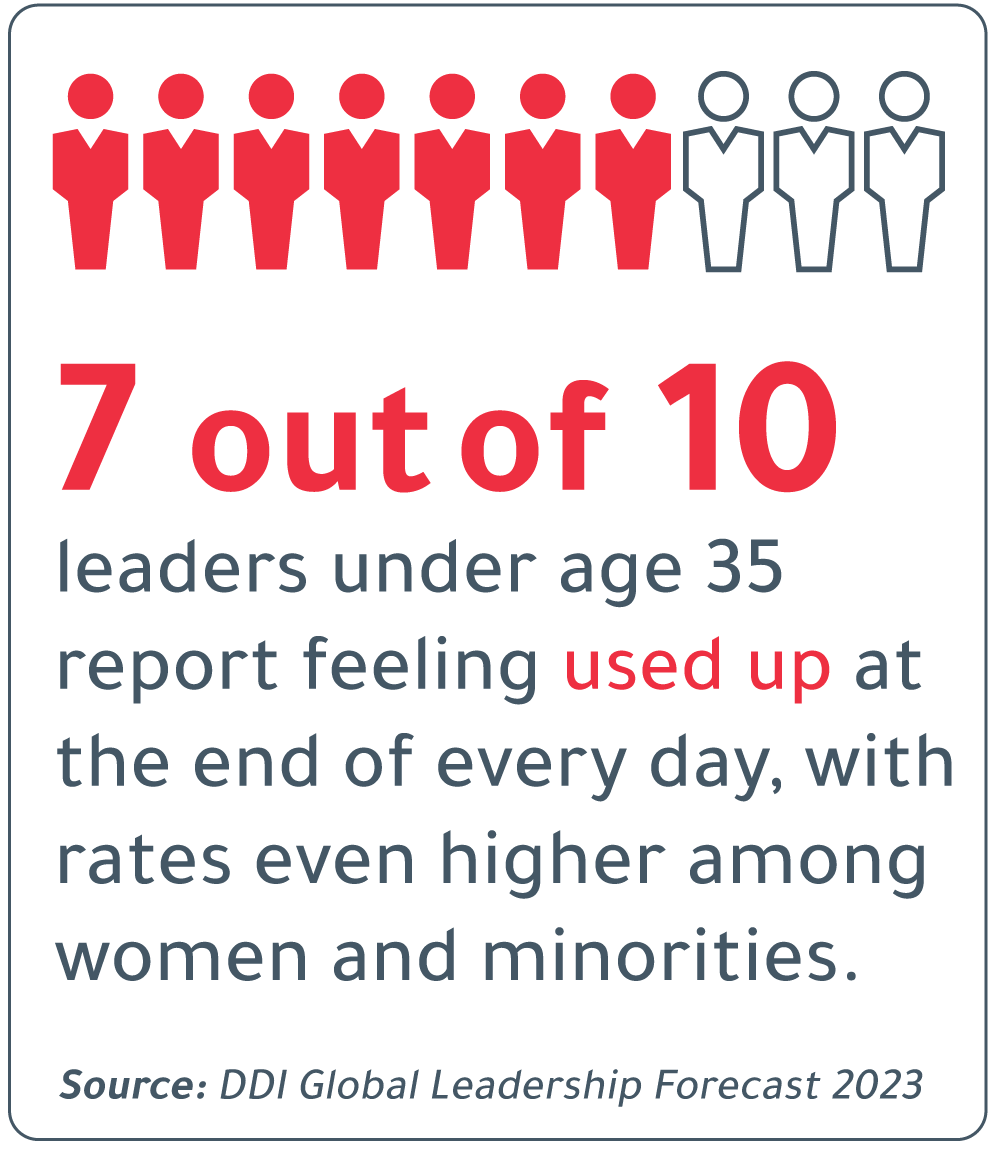When emotions run high, it may be tempting for leaders to want their teams to discard their feelings at the door, focusing on the work at hand. But attempting to create a feelings-free workplace is never the solution. Leading with emotional intelligence will have a better short- and long-term payoff.

The problem is rarely that leaders are coldhearted. Rather, leaders feel the pressure themselves and are trying to control their own stress. They are faced with monumental tasks to pivot the company and their teams. They feel the weight on their shoulders to show a brave face for their team and keep the cogs turning. And it may seem counterproductive to focus on feelings when there’s so much work to be done.
But ignoring their team’s emotions can lead to disengagement. Employees may struggle to put in the bare minimum effort. And high-performing employees become a risk for burnout and leaving.
Not only do business results suffer, but it can take a deep physical and mental toll on employee health.
That’s why leading with emotional intelligence is so important.
What is leading with emotional intelligence?
Author and international leadership consultant Adele Lynn offers this definition of emotional intelligence (EI):
“Emotional intelligence is the ability to manage yourself and your relationships with others so that you truly live your intentions.”
This definition supports our observations that leaders don’t intend to be compassionless. Often, they focus only on what practically needs to be done, while forgetting about others’ personal needs. This is when the disconnect begins. Without emotional engagement, it’s tough to drive sustained, high-quality team performance. As a result, leaders end up frustrated and confused about why they aren’t getting the result they intended.
We hear that sentiment from leaders a lot as they grapple with what it means to lead with emotional intelligence. Leaders often ask:
- What does it mean to “demonstrate empathy”?
- How can leaders show empathy during disruptive or challenging times?
- How do you get leaders to buy into empathy…and not just the bottom line?
- How can leaders create a consistent culture of caring?
Training leaders to lead with emotional intelligence may not be easy, but the results are worth the effort. Organizations that lead with empathy see higher employee engagement, productivity, and retention and lower rates of burnout. And all of these give your company a far better chance of reaching your overall goals.
There are three steps to support your leaders on the path of leading with emotional intelligence.
Step 1: Acknowledge Personal Derailers
Remember the classic airline advice to put your own oxygen mask on before assisting other passengers? We recommend a similar approach to leadership. When leaders don’t have a handle on their own stress, they will struggle to support others. As a result, their negative personal tendencies, what we call derailers, start to show up under stress.
Derailers are the “dark side” of our personality, and we all have them. These include personality traits like becoming argumentative, controlling, or impulsive under stress. We can’t change our personalities, but we can learn to manage our reactions and responses under stress.
4 Ways to Manage Derailers
- Anticipate upcoming stressful situations and ask yourself, “What outcome do I really want?” Then, if you start to feel stress coming on once you get in the situation, PAUSE and count to 10 (or at least 5!). Taking a moment before you respond can help make sure you respond in a way that reflects your intentions.
- Acknowledge, but don’t celebrate, your derailers. If you overreacted to something, you could apologize. But apologies wear thin after a while. It’s not OK to use derailers as a justification, i.e., “I’m sorry, but I just had to say that…I am impulsive.”
- Manage your physical and emotional health to support keeping yourself in the best state of mind.
- Practice, practice, practice!
HR and leadership coaches can also help leaders manage their own emotions. They can help identify leaders who are under the most stress and talk with them about managing their emotional triggers. They can also help leaders pause by asking key questions such as “Which upcoming situations are most concerning?” Or “What type of outcome is important to you?”
Then leaders can begin planning for the challenges ahead of managing their own emotions while leading with emotional intelligence.
Step 2: Read the Room
Leaders need to work on recognizing emotions in others. In other words, they need to practice empathy.
However, some leaders confuse empathy with sympathy. Empathy is the ability to understand other people’s perspectives. Sympathy is feeling pity and sorrow for someone else’s misfortune.
Many leaders struggle to show empathy because they think it means they have to feel bad for the person or they can only respond if they have faced similar scenarios firsthand, i.e., “I’m sorry you’re feeling so stressed. I understand why you didn’t get the report done.”
But that’s not the case. Empathy does not require you to agree with the person’s opinions or actions. It’s simply the acknowledgment of how they’re feeling and why they are feeling that way.
For example, a leader can empathize by using a straightforward formula:
“It sounds like you’re_(feeling)__ because / about ___(fact)____.”
In an actual conversation:
“From all you’ve shared, it sounds like you’re overwhelmed because there are so many competing priorities right now.”
Empathy also doesn’t require leaders to have the answers.
Leaders often fall into the trap of wanting to "fix" situations for their employees, but until they have demonstrated true active listening by capturing the facts, feelings, and showing that they understand how the person feels then they cannot move to the practical next steps. Acknowledging feelings of uncertainty, stress, and pressure to perform goes a long way to helping people feel understood. As a result, they can feel more engaged and motivated to be part of the solution.
Step 3: Be a Part of the Solution
The final step is the one that drives results. As leaders get a handle on their own emotions and the emotions of their teams, they can start to mobilize people toward what needs to be accomplished.
Leaders can mobilize their teams by seeking three things:
- Seek perspective: “What do you see as the biggest impact from the changes?”
- Seek help: “Which priorities seem to be competing the most?”
- Seek ideas: “What’s a better way I can communicate the priorities so you truly know what is a priority?”
And then comes the hard part: Leaders need to listen to and act on their team’s feedback. That doesn’t always mean doing what teams suggest. But they do need to find a way to acknowledge and incorporate comments into the final solution. Even when team ideas won’t work, leaders can build trust by sharing rationale for why suggestions will not be incorporated.
Don’t get us wrong. A three-step formula isn’t the magic bullet to resolve the complex challenges leaders face. But by helping leaders stabilize their knee-jerk reactions, recognizing what the team member is dealing with, and involving them in the solution, leaders can get a leg up in avoiding team burnout and moving forward more quickly.
Emotional Intelligence Spans All Leader Levels
While we place significant focus on how frontline leaders need to lead with emotional intelligence, these lessons apply higher up the ladder, too. At the senior levels, your leaders need to be guiding the organization through the five phases that will lead to your business transformation.
But it doesn’t work to just lay out a plan. Driving business transformation requires you to engage people’s hearts and minds. And when you do, the rewards will be outstanding.
Emotional intelligence is a critical piece of your engagement and retention strategy. Learn how to get it right in A Practical Guide to Employee Engagement and Retention.
Verity Creedy is Vice President of DDI’s Product Management team and an award-winning blogger. Verity is obsessed with building powerful development experiences for leaders, trying to hold a decent plank for two minutes, and keeping indoor plants alive for more than six months.
Scott Wolf is a Sr. Consulting Manager in DDI’s US Operations. He is madly passionate about helping leaders uncover their blind spots (and his own!). Most of his time is spent asking pesky, provocative questions and figuring out why his teenager is obsessed with Tik Tok.

